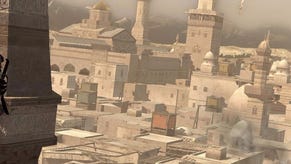Face-Off: Assassin's Creed II
Splitting heirs.
This is the game I've been waiting for. While the original Assassin's Creed may have been short on variety, there's no denying the quality of the visuals and the immense possibilities of the openworld sandbox it presented to us. On Xbox 360, at least, it was a technological marvel that laid the foundations for a sequel that takes all the coding genius of the original and combines it with a gameplay package that exceeds expectations. While Modern Warfare 2 ranks as the multiplayer game of choice for console owners, it's Assassin's Creed II that offers the most complete package for those more enamoured with traditional single-player experience. Ubisoft Montreal has done good.
Assassin's Creed is a game that comes with a bit of history. Way back in Face-Off Round 6, the PS3 version was savaged for its hugely disappointing performance, general blurriness and the feeling that its development was treated almost like an afterthought compared to the more technically solid Xbox 360 game. Times have changed. The quality of Ubisoft's PS3 work has come on leaps and bounds (its penchant for mammoth mandatory installs aside) and the fact the quality level has been sustained across the entire company with its many and varied studios is all the more impressive.
With regards to Assassin's Creed II, the comparison video augers well, suggesting that slight blur aside, the graphical assets are indeed identical cross-platform. You can get a more in-depth view with the jam-packed 720p comparison gallery.
Let's deal with the basic rendering spec. Similar to the first Assassin's Creed, ACII runs at native 720p resolution, with 2x multi-sampling anti-aliasing on Xbox 360 and quincunx edge-smoothing on PS3. The net result is that the PS3 has fewer "jaggies" at the expense of every texture in the game getting an unwelcome blur.
There have been some reports circulating that PS3 gets some special 1080p treatment in the form of a 960x1080 res - which would be a 12.5 per cent resolution boost, albeit with some oddly shaped pixels. The reality is somewhat different. If our pixel measurements are right, the PS3's 1080p mode - only active if 720p is disabled - seems to indicate the resolution has been reduced to 960x720. Combined with the quincunx, it's a blur-fest, as you can see in the upscaled 1080p comparison gallery. In short, it's a 720p game and really should be run as such.
In a year that has seen the HD consoles (and most especially PS3) pushed to new limits in performance, just how much of a leap have we seen with Assassin's Creed II? After all, the original game was one of the most advanced console titles ever seen back in its heyday in 2007 and, to this day, it's still an incredibly impressive title, with only a variable frame-rate and dollops of screen-tear blotting the copy book.
There are enhancements to the core tech, but it's fair to say that the overall impact during gameplay is limited. Perhaps the most impactful change is Ubisoft Montreal's inclusion of a full day/night cycle, dictating overall lighting throughout the game. A full 24-hour cycle is around 60 minutes of game, and it is interesting to note that starting a new mission resets the clock to a Doctor Who-style fixed point in time. Presumably Desmond's memories are being put back into sync with Ezio's, which is a nice touch. There's also a very nice Animus effect that sees the environments being reconstructed from their component vertexes as you enter the cityscape.
All of this is brand new, but make no mistake, the core tech itself is much the same as the game we played two years ago and initial impressions are that the original's cities had more character and detail than those we see in the sequel. There's even a very strong argument that the environments outside of the cities have been significantly pared down in terms of detail level and content compared to the first game. All I can say about this is that the further you get into the game, the more impressive it becomes, with the arrival in Venice signifying a new high point in technical excellence.
So what about the performance level? First off, it's probably best to remind ourselves of the huge gulf in quality between the PS3 and Xbox 360 versions of the first game. While the Face-Off coverage of the time was very controversial, the bottom line is that with the analysis tools we have available now, we can see just how much of a raw deal the Sony platform got technologically speaking.
Many view the original Assassin's Creed as something of a huge, expansive tech demo roughly manhandled into a somewhat limited game, and while both games were prone to losing frames and tearing, PS3 performance was a bit of a joke: frame-rate reaches a nadir of 17FPS at its lowest point, with 37 per cent of the 60Hz output of the console consisting of torn frames. That's compared with a mere six per cent on 360 and a 24FPS minimum. So for PS3 owners, a tech demo that underperforms technically. Not good.
The Assassin's Creed Forge technology has since been used for other games from Ubisoft. I ran a rough performance measure back in July on each of them, and the conclusion was obvious: the Assassin's Creed engine can deliver the goods. In terms of the almost mythic cross-platform parity, Prince of Persia was one of the best-realised PS3/360 titles of last year.









